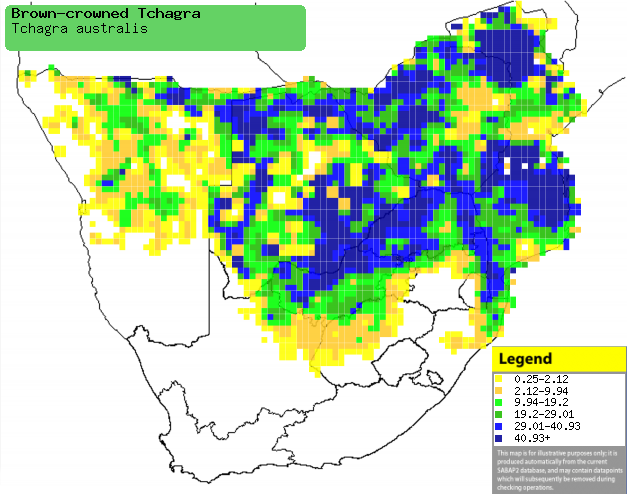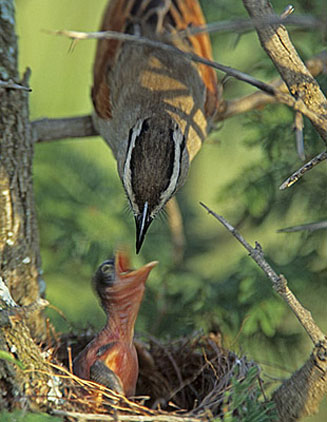|
Tchagra australis (Brown-crowned
tchagra, Three-streaked tchagra)
Driestreeptjagra [Afrikaans]; Rooivlerktjagra [Afrikaans];
Eyimba (generic term for tchagra) [Kwangali]; Umnguphane (generic term for
tchagra) [Swazi]; Mghubhana lowu tsongo [Tsonga]; Bruinkoptsjagra [Dutch];
Tchagra à tête brune [French]; Damaratschagra [German];
Picanço-assobiador-de-coroa-castanha [Portuguese]
Life
> Eukaryotes >
Opisthokonta
> Metazoa (animals) >
Bilateria >
Deuterostomia > Chordata >
Craniata > Vertebrata (vertebrates) > Gnathostomata (jawed
vertebrates) > Teleostomi (teleost fish) > Osteichthyes (bony fish) > Class:
Sarcopterygii (lobe-finned
fish) > Stegocephalia (terrestrial
vertebrates) > Tetrapoda
(four-legged vertebrates) > Reptiliomorpha > Amniota >
Reptilia (reptiles) >
Romeriida > Diapsida > Archosauromorpha > Archosauria >
Dinosauria
(dinosaurs) > Saurischia > Theropoda (bipedal predatory dinosaurs) >
Coelurosauria > Maniraptora > Aves
(birds) >
Order: Passeriformes
> Family: Malaconotidae
Distribution and habitat
Widespread across Sub-Saharan Africa, absent only from the
Congo Basin and areas of Tanzania. In southern Africa it is locally common from
the North-West Province, Eastern Cape, KwaZulu-Natal and Mpumalanga through
Mozambique, Zimbabwe, Botswana to much of Namibia. It is quite adaptible,
occurring in a wide range of habitats including bushy savanna, arid thornbush,
Miombo, Mopane and other broad-leaved woodlands, gallery forest and suburban
gardens.
|
 |
|
Distribution of Brown-crowned tchagra in southern Africa,
based on statistical smoothing of the records from first SA Bird Atlas
Project (©
Animal Demography unit, University of
Cape Town; smoothing by Birgit Erni and Francesca Little). Colours range
from dark blue (most common) through to yellow (least common).
See here for the latest distribution
from the SABAP2. |
Food
It mainly eats insects and their larvae, doing most of its
foraging on the ground, plucking prey from the base of plants. It also gleans
them off leaves and branches in the canopy and occasionally catches prey
aerially. The following food items have been recorded in its diet:
- Insects
- Small Vertebrates (rarely)
Breeding
- It is a monogamous, solitary nester with males vigorously defending their
territories using flight displays and calling.
- Both sexes construct the nest, which is a shallow cup made of rootlets,
fine twigs, coarse grass and leaf stems, cemented with spider web. It is
usually placed in a fork or horizontal branch of a bush, well concealed by
foliage.
 |
|
|
Brown-crowned tchagra feeding its chick,
Sericea farm, South Africa. [photo Warwick Tarboton ©] |
|
- Egg-laying season is from about September-March, Peaking from
October-December.
- It lays 2-4 eggs, which are incubated mainly by the female for roughly
14-17 days. The male doesn't do much incubating, but he defends their
territory and often feeds his mate at the nest.
- The chicks are leave the nest at about 13-16 days old, after which they
remain with their parents for at least 5 months.
Threats
Not threatened.
References
-
Hockey PAR, Dean WRJ and Ryan PG 2005. Roberts
- Birds of southern Africa, VIIth ed. The Trustees of the John Voelcker
Bird Book Fund, Cape Town.
|
